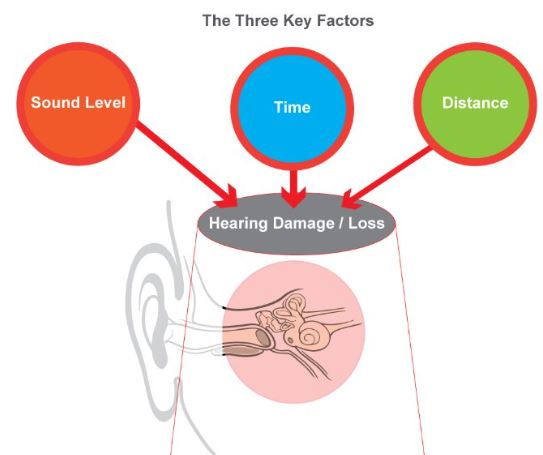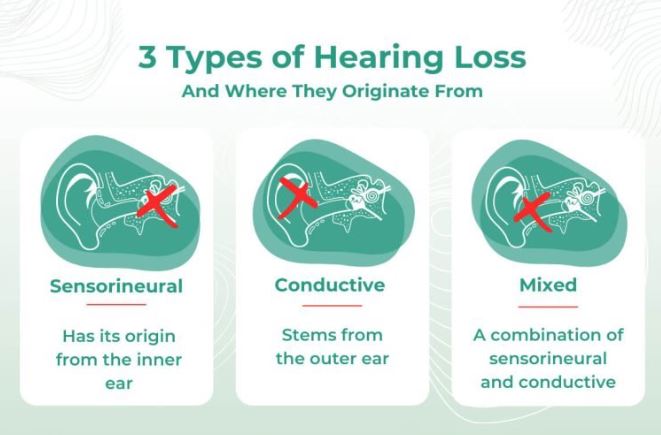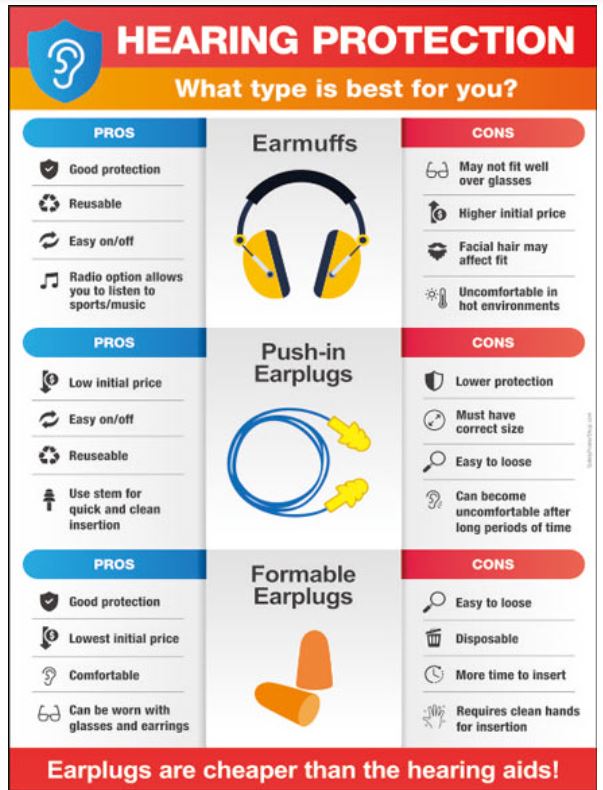Do people working in different professions hear differently?
Grade 5
Presentation
Hypothesis
My hypothesis is that there is a (significant) difference in the maximum hearing frequency for professionals working in the high sound exposure professions like military, construction, manufacturing, and music industry as compared to normal sound exposure professions like IT and librarians. (Age group 40-50 years)
Research
How do we hear?
1. In the outer ear, sound waves enter through the ear canal and vibrates the ear drum which sends these vibrations to the middle ear.
2. In the middle ear, there are three tiny bones called Malleus, Incus and Stapes. These bones amplify the sound vibrations and send them to Cochlea in the inner ear.
3. In the inner ear, sound vibrations move the fluid inside the Cochlea and the fluid motion moves the hair cells and creates an electrical signal that gets sent to brain through auditory nerve.
What factors affect hearing loss?
1. Intensity of noise (dB level): Loud sounds can cause severe hearing loss.
2. Duration of exposure: Longer exposure to high noise can cause faster hearing loss.
3. Distance: Short distance from the noise source can cause more hearing loss.
What are the different types of hearing loss?
1. Sensorineural: It has its origin from the inner ear. It can be caused by aging, loud noises and medicine side effects.
2. Conductive: It has its origin from the outer ear. It can be caused by fluid, impacted ear wax and ruptured ear drum.
3. Mixed: It is a mix of the sensorineural and conductive hearing loss. It can be caused by genetic diseases, head trauma and infection.
Why people working in professions with exposure to loud noises can experience hearing loss?
The normal hearing range for humans is 20 Hz to 20,000 Hz (20 kHz). Exposure to occupational noise can reduce the upper hearing limit over time.
Occupations that expose individuals to loud sounds above 85 dB can cause hearing loss over time. This occurs because loud noise damages the hair cells in the cochlea, which are responsible for sending sound signals to the brain.
Below are examples of professions with exposure to loud sounds:
-
Military: Gunfire, bombs and explosions (130+ dB) can cause severe and/or immediate hearing damage, including tinnitus.
-
Construction: Loud sound exposure (90-120+ dB) to loud machinery, e.g. jackhammers and drills, can lead to permanent hearing damage.
-
Manufacturing: Exposure to loud manufacturing processing (100-120+ dB), e.g. Jet cutting, heavy forging, CNC machines, grinders.
-
Musicians: Long term exposure to loud music (85-115 dB) can cause gradual hearing loss.
How can we protect our ears and prevent hearing loss?
1. Wearing protective gear: Noise-canceling headphones, earmuffs, and earplugs should be used to reduce exposure to loud noises.
2. Reducing exposure time: Taking breaks from loud noise environments reduces our exposure time and can help prevent hearing loss.
3. Regular hearing tests: It helps to detect early signs of damage.
4. Using quieter equipment: Switching to low-noise tools can prevent or reduce hearing loss.
Variables
Manipulated Variable: Profession.
Constant Variables: Age group, Sound source and Sound volume.
Responding Variable: Maximum hearing frequency.
Uncontrollable Variable: Random insignificant background noises.
6 Professions are chosen for this project:
-
4 Experimental group professions: Military, Manufacturing, Construction and Music professionals (Exposure to loud sounds: 100-130+ dB).
-
2 Control group (baseline) professions: IT professionals and Librarians (Exposure to normal sound levels: 40-60 dB).
Procedure
Procedure:
- Prepare a data capturing sheet for 30 people between the age 40-50 years with 5 people working in each of the six chosen professions. Six chosen professions are: Military, Musicians, Construction, Manufacturing, Information Technology and Librarians.
- Ensure there is no noise in the room.
- Play the sound using same sound web source to generate sound frequencies (Online Tone Generator - generate pure tones of any frequency (szynalski.com)) and maximum volume.
- Start with 1000 Hz frequency and slowly increase the sound frequency till the person stops hearing the sound.
- Capture the maximum hearing frequency and profession of the person om the log book.
- Repeat the experiment for five people working in each of the chosen six professions.
- Calculate the average maximum hearing frequency for people working in each six professions.
- Compare the difference in the average maximum hearing frequency for people working in six professions to test the hypothesis.
- Conclude the findings.
Observations
- I conducted 5 experiments for each of the six chosen professions for people in the age group 40-50 years.
- Below is the summary of the 30 observations along with the average maximum hearing frequency for six professions:
Analysis
-
The average maximum hearing frequency was calculated for 5 people working in each of the 6 chosen professions.
-
The maximum hearing frequency is significantly less (24%) for people working in the experimental group professions as to control group professions.
-
Here are some examples of professions with loud and normal sound exposure:
- Military: Gunfire, bombs and explosions (130+ dB) can cause severe and/or immediate hearing damage, including tinnitus.
- Construction: Loud sound exposure (90-120+ dB) to loud machinery, e.g. jackhammers and drills, can lead to permanent hearing damage.
- Manufacturing: Exposure to loud manufacturing processing (100-120+ dB), e.g. Jet cutting, heavy forging, CNC machines, grinders.
- Musicians: Long term exposure to loud music (85-115 dB) can cause gradual hearing loss.
- IT Professionals – Typically quiet office environments (40-60 dB).
- Librarians – Very low noise exposure (30-50 dB).
See the graphical comparison of average maximum hearing frequency for 6 chosen professions:
Conclusion
-
The hypothesis is validated: There is a 24% difference in the average maximum hearing frequency for professionals working in the high sound exposure professions like military, construction, manufacturing, and music industry as compared to normal sound exposure professions like IT and librarians. (Age group 40-50 years).
-
The average maximum hearing frequency for the experimental group professions was 24% (3234 Hz) lower than the controlled group professions.
Application
The findings of this project can help provide targeted insights and solutions to:
-
Mitigate noise induced hearing loss (NIHL).
-
Educate professionals on the early signs of hearing damage.
-
Optimize alarm & alert systems: Different occupations may require alarms at specific frequencies. Workers with prolonged exposure to loud noises might have reduced sensitivity to high frequencies, requiring lower-frequency alarms for better recognition.
-
Optimize communication systems and devices: Speech perception of professionals with frequency-dependent hearing loss may be affected, requiring adjusted audio frequencies in headsets or communication devices e.g. Healthcare and call center communication management.
-
Design audio equipment to cater to the specialized needs of certain professions. Audio devices can be tailored to certain frequency hearing loss and improve people's hearing.
Future plan:
I would like to test the hearing abilities of this age group and professions by gender to test whether there is a significant difference in the maximum hearing frequency.
This would help shine light on any potential gender-based programs needed at workplaces in case the hypothesis is validated.
Sources Of Error
- Random insignificant background noises in the experimental environment.
- Any significant source of background noise was controlled. The random background noises were minimized by closing the doors and windows while ensuring there is no inside source of noise/sound.
Citations
How do we hear?
-
Johns Hopkins Medicine. (n.d.). How the ear works. https://www.hopkinsmedicine.org/health/conditions-and-diseases/how-the-ear-works
What factors affect hearing loss?
-
Duration and Intensity of Noise Exposure: World Health Organization. (2025). Deafness and hearing loss. https://www.who.int/news-room/fact-sheets/detail/deafness-and-hearing-loss
-
Protective Gear: Centers for Disease Control and Prevention. (2024). Types of hearing loss. https://www.cdc.gov/hearing-loss-children/about/types-of-hearing-loss.html
What are the different types of hearing loss?
-
Centers for Disease Control and Prevention. (2024). Types of hearing loss. https://www.cdc.gov/hearing-loss-children/about/types-of-hearing-loss.html
Why do people working in different professions/occupations experience hearing loss?
-
Occupational Noise Exposure: National Institute on Aging. (2023). Hearing loss: A common problem for older adults. https://www.nia.nih.gov/health/hearing-and-hearing-loss/hearing-loss-common-problem-older-adults
How can we protect our ears and prevent hearing loss?
-
Protective Measures: World Health Organization. (2025). Deafness and hearing loss. https://www.who.int/news-room/fact-sheets/detail/deafness-and-hearing-loss
Applications:
-
Optimizing Alarm & Alert Systems: Centers for Disease Control and Prevention. (2024). Types of hearing loss. https://www.cdc.gov/hearing-loss-children/about/types-of-hearing-loss.html
-
Optimizing Communication Systems and Devices: Hearing Loss Association of America. (2023). Types, causes and treatments. https://www.hearingloss.org/understanding-hearing-loss/types-causes-and-treatments/
Sound Source:
-
Online Tone Generator: Szynalski, T. P. (n.d.). Online tone generator. https://www.szynalski.com/tone-generator/
Acknowledgement
I would like to thank my teachers and science fair coordinators for their guidance for my project. I am grateful for my parents for their support and helping me to find resources. I would also like to thank the participants for allowing me to test their maximum hearing frequency and making this project successful.






